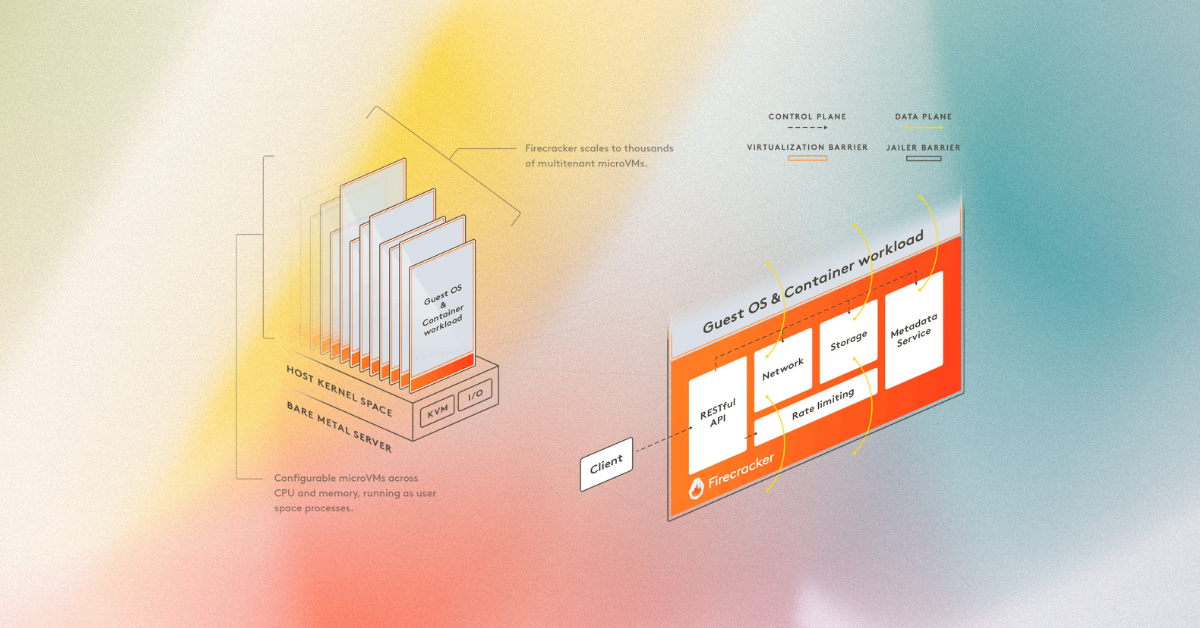Introduction to Firecracker MicroVM
Firecracker is an open-source virtualization technology designed by Amazon Web Services (AWS) to run lightweight virtual machines (VMs) called microVMs. Initially developed to enhance AWS’s Lambda and Fargate services, Firecracker now empowers cloud-native applications, serverless computing, and container-based environments with fast, efficient, and secure virtualization at scale.
At its core, Firecracker leverages KVM (Kernel-based Virtual Machine) for Linux and offers a minimalistic, low-overhead environment designed to launch and manage microVMs. It strikes a balance between the isolation benefits of virtual machines and the speed and efficiency traditionally associated with containers.
Key Features of Firecracker
- Lightweight Virtualization: Firecracker’s design prioritizes efficiency by minimizing the amount of resources required for each microVM. Unlike traditional VMs, which might include a wide range of features that are unnecessary for modern workloads, Firecracker only includes what’s needed for serverless and containerized tasks. This keeps the microVM lean and improves startup times and resource consumption.
- Fast Boot Times: MicroVMs created by Firecracker can launch in less than 125 milliseconds, making it ideal for workloads requiring rapid, on-demand scaling. This speed is crucial for serverless applications like AWS Lambda, which benefit from quick initialization and execution.
- High Density: Firecracker allows thousands of microVMs to run on a single host without performance degradation. This high-density capability is critical for companies looking to maximize their hardware utilization in cloud environments.
- Enhanced Security with Jailers: Firecracker introduces a concept called Jailers, which enforces a minimalist security posture by limiting the resources a microVM can access. This ensures the microVM operates within a restricted, highly secure environment, reducing the attack surface for potential vulnerabilities.
- Minimal Device Emulation: Firecracker supports a minimal set of devices, including a network interface, a block device, a serial console, and a simple timer. By cutting down on device emulation, Firecracker reduces complexity, which in turn enhances performance and security.
- KVM-based Architecture: By leveraging the KVM hypervisor, Firecracker can offer near-native performance for microVMs. This design helps it blend the performance advantages of containers with the isolation and security benefits of traditional VMs.
Firecracker vs. Traditional Virtualization Solutions
Firecracker offers a distinct value proposition compared to traditional VM-based or container-based solutions:
- Lower Overhead: Firecracker’s minimalistic approach means it consumes fewer resources than conventional VMs. While containers offer fast start-up times, they rely on shared kernels and namespaces, which can compromise security and isolation. Firecracker bridges this gap by offering lightweight VMs with improved security isolation.
- Rapid Scaling: Cloud-native and serverless applications benefit immensely from Firecracker’s ability to scale quickly. For example, AWS Lambda, which needs to scale rapidly to meet demand, uses Firecracker to spin up new microVMs in milliseconds, avoiding the heavier start-up times of traditional virtualization solutions.
- Security Isolation: Containers are inherently limited by their shared kernel architecture. Firecracker, on the other hand, uses a hypervisor-based architecture, providing superior isolation for workloads. This makes Firecracker an attractive solution for multi-tenant environments or services requiring robust security.
Use Cases for Firecracker
- Serverless Computing: Firecracker has become the backbone of AWS Lambda, a serverless platform where code is executed in response to events. Firecracker enables rapid scaling and teardown of isolated microVMs, making it an ideal solution for serverless architectures.
- Containerized Workloads: Firecracker can also be used to run containers securely inside microVMs, giving users the security benefits of VMs without the overhead. This is especially beneficial for organizations that want to combine the lightweight advantages of containers with the security and isolation benefits of virtualization.
- High-Density Virtualization: Firecracker allows cloud service providers to pack thousands of isolated workloads onto a single physical host without sacrificing performance or security, making it a strong contender for multi-tenant hosting environments.
- Edge Computing: Firecracker’s lightweight and fast-booting microVMs are also ideal for edge computing, where low-latency processing close to data sources is required. It enables edge devices to run multiple isolated workloads efficiently while minimizing resource usage.
How to Get Started with Firecracker
- Installation: Firecracker is supported on Linux hosts with KVM. You can download and install Firecracker from its GitHub repository.
- Creating a MicroVM:
- Firecracker allows you to create a microVM by running a simple command that defines its configuration (vCPU count, memory, disk, etc.). You can use JSON-based API calls to define and control your microVMs.
firecracker --api-sock /tmp/firecracker.socket
- Once the API server is running, you can use
curlto make API calls that configure the microVM. - Running Workloads: Firecracker supports running different types of workloads, from small serverless applications to full containerized environments. It offers flexibility in the choice of OS for the guest VM, and it works with any modern Linux distribution.
The Ecosystem Around Firecracker
- Firecracker Containers (firectl): firectl is a lightweight command-line tool that helps manage Firecracker microVMs. It simplifies starting and managing microVMs and is often used for running container workloads securely within Firecracker.
- Weave Ignite: Weave Ignite is another project built on Firecracker that combines the ease of container workflows with the security of VMs. It allows developers to deploy microVMs like containers using
kubectlor Docker-like commands. - Firecracker for Kubernetes: Several ongoing projects are exploring Firecracker as a secure runtime for Kubernetes pods. Using Firecracker under Kubernetes helps enhance the security and isolation of each pod without the overhead of traditional VMs.
The Future of Firecracker
Firecracker is poised to grow in influence as cloud-native, and serverless computing trends continue to dominate. With its lean design, strong focus on security, and rapid scaling capabilities, Firecracker enables enterprises to efficiently manage and scale secure workloads.
Moreover, Firecracker’s integration into larger cloud ecosystems, such as AWS Lambda, and its potential use in Kubernetes environments, positions it as a game-changer in virtualization technology. As microVMs continue to gain traction in edge computing, IoT, and multi-tenant cloud environments, Firecracker is set to lead the charge in making scalable, secure, and efficient virtualization accessible to all.
Conclusion
Firecracker represents a significant advancement in virtualization technology. With its focus on fast-booting, lightweight, and secure microVMs, it addresses the needs of modern workloads and cloud-native applications. Whether you’re running serverless applications, containerized workloads, or multi-tenant environments, Firecracker offers a compelling solution that blends the best of both VMs and containers.
For developers and infrastructure engineers looking to explore efficient, scalable, and secure microVM-based virtualization, Firecracker is a technology worth diving into. Visit Firecracker’s official site to get started, and experience the future of lightweight virtualization.



Leave a Reply